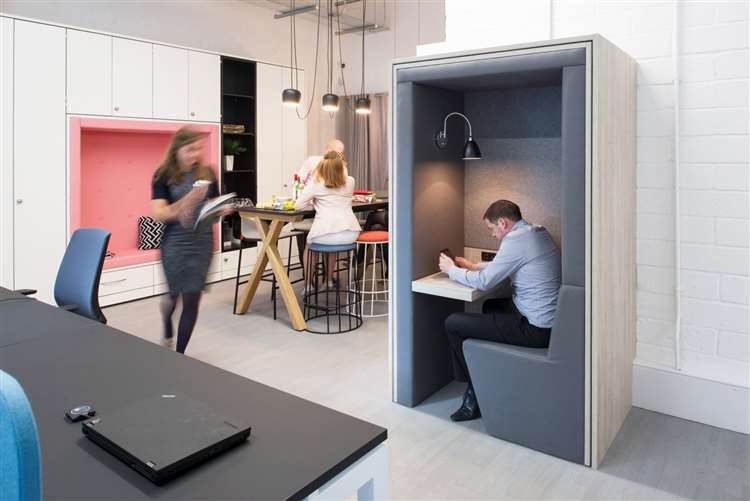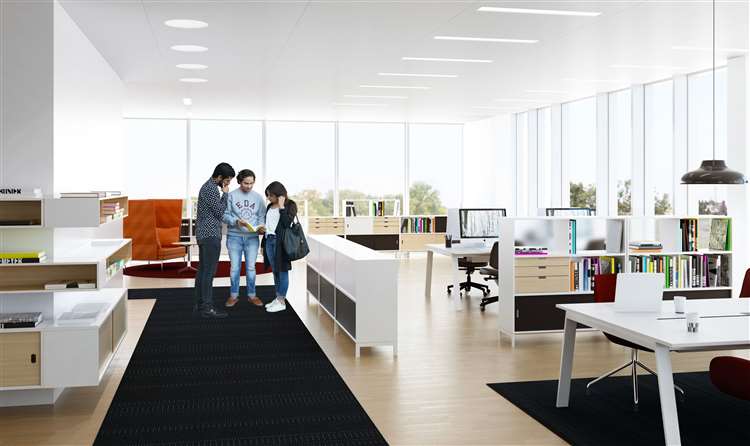Activity Based Working (ABW) has emerged as one of the fastest growing design trends; it is a people and task-centric model which addresses the problems and criticisms of open plan office design. Businesses are enlisting the help of commercial interior designers to help design their offices to include more choice of workplace design to suit both task and work style.
Workplace transformation is growing. A piece of research carried out by CBRE found that 86% of organisations were reinventing or adapting their workplace standards last year. But is ABW right for all organisations – or can training and organisational approach affect its effectiveness?

Provide flexibility and choice
Today's workforce expects options. Leading organisations incorporate a variety of spaces that support the various needs and preferences of employees. Key to activity-based working is the belief that employees should not have a single assigned workstation. Instead, businesses work with office space planning experts to create a number of different work areas, which each enable a certain kind of activity to take place. So, for example, there may be areas for concentrated work, areas for collaborative work, areas for meetings, and areas for socializing and 'accidental exchanges of ideas'.
Everyone needs access to private space to support concentration and focused work, and surprisingly, most offices do not provide enough. A balance of spaces for concentration and collaboration ensures the work people are doing is catered for. But what good are options if they don’t suit your mobility profile or activity, or if you're not trained or encouraged to use them, or worse the physical infrastructure doesn’t support this? To effectively incorporate ABW requires internal analysis and skilled designers to implement it correctly for each organization’s make up.
Incorporating the right spaces should be paired with empowering staff to make that choice. People thrive when you untether them from one type of space and allow them to choose the best place or setting that's most conducive to the task at hand. Choice and flexibility are especially important when catering to a distributed workforce that's often flowing in and out of multiple work locations (e.g. home, office, client site, etc.).
An example of an office revolutionized by activity-based working is Microsoft Netherlands' office in Amsterdam. As part of the design, the company did away with private offices, ensuring all employees are equal. It provides a variety of different workspaces and meeting rooms, as well as a coffee shop area, and allows employees to move around freely. As a result, the company has reduced real estate costs by 30% and claims to have boosted productivity.

Leesman Research
Leesman, a leading independent research organization on workplace – has recently conducted an in-depth report on the successes and limits of ABW. This focused approach utilizes data on how more than 1,700 workplaces in 63 countries support 220,000+ employees in the work they are employed to do.
They begin by questioning and examining people working in ABW workplaces and benchmarking them against a control group. They have identified 4 mobility profiles:

Data source: ‘The Rise and Rise of Activity Based Working, the Leesman Review 2017’
Contrary to what one many assume, the youngest employees are the most sedentary and least likely to adopt a more mobile behaviour with 84% of the under 25’s belonging to mobility profiles 1 and 2.
The respondents with a simpler activity profile tend to be more likely to base themselves at a single work setting (44% of these respondents belong to mobility profile 1 and 36% to profile 2). They do not adopt more mobile behaviour – perhaps as the nature of their work is not especially diverse and therefore does not require a multitude of settings. By far the most important activity for these employees is in fact “individual focused work or desk-based”, which was selected as an important activity by 81% of these respondents. Only 8% consider “individual focused work, away from the desk” to be important.
The data suggests that adopting mobile behavior becomes even more effective when the activity profile becomes more complex – in other words, when it includes a wide variety of activities Employees in ABW workplaces who report the highest level of mobility (profile 4) are more likely to perceive that their activities are supported, compared to the control group. In addition, the employees with higher mobility are also generally more satisfied with their various workplace features, compared to the least mobile respondents.
In total, 67% of employees working in ABW environments agreed that the design of their workplace encourages them to choose work settings that best suit their current task, while 82% agreed that the technology and infrastructure is in place for them to work in different locations throughout the office. Meanwhile, 81% felt their company culture enables this, and 70% agreed they have the right support and training.
Ostensibly, these are encouraging statistics. However, it is worth noting that only 46% of employees agreed with all four statements. As a result of this, the study found that a substantial number of employees did not actually embrace the new way of working. This highlights the importance of making sure that office design services and internal procedures address these challenges and support the adoption of activity-based working.
Significant highlights of the study include:
Creative thinking
Here ABW environments outperform other environments for those employees with higher mobility profiles. But those with a less mobile profile are left with a lower perceived support compared to the control group environments.
Individual Focus
While ABW environments perform less well from an employee satisfaction perspective for “individual focused work or desk based”, for those with higher mobility profiles that is compensated for with the gains in satisfaction in “individual focused work away from your desk”.
Informal meetings
This is an area where ABW spaces consistently excel, delivering higher employee satisfaction averages across all four mobility profiles. If this forms part of a project objective, this is an area where ABW has the potential to bring employees real benefit.
Paper
Almost all ABW spaces record lower than average satisfaction figures for “spreading out paper and materials”. Organizations moving to ABW need to assess the importance of this activity to their employees and decide if reducing reliance on paper is appropriate or achievable.
Findings Summarized:
Leesman findings show a mix of results: that ABW increased staff collaboration, productivity, workplace pride and effectiveness. But also uncovered a series of shortcomings and challenges that should be highlighted to any organization considering adopting an ABW workplace environment.
Key points
1. Activity-based working can deliver significant operational benefits for those employees who use the environments provided for them.
2. The more an employee uses multiple work locations within the workplace, the more they report that the space enables them to work more effectively.
3. The more complex an employee’s daily work profile, the more beneficial it is for them to work in a mobile way that utilises multiple settings.
4. Poor adoption of appropriate behaviour in activity-based workplaces is a significant problem that limits widespread organisational benefits.
The best ABW environments deliver valuable employee satisfaction and workplace pride gains on many key workplace activities.
At the same time, you need to ensure that the infrastructure and technology is in place to allow people to move, without compromising the quality of their work.
When executed well, the benefits far outweigh the minor losses, but need to be matched to organisational style, and objectives. Coupling this with a more efficient space-saving floor plan which reduces real estate costs often makes great business sense.
With extensive experience as a commercial interior designer and workplace consultant, Eve Waldron recommends ways in which to match ABW to your business working environment and organisational style.
ewop is an online platform specialising in workplace furniture by knowledgable designers. We have tested & selected our favourite design-led pieces that work well together, making furnishing your office easy.






